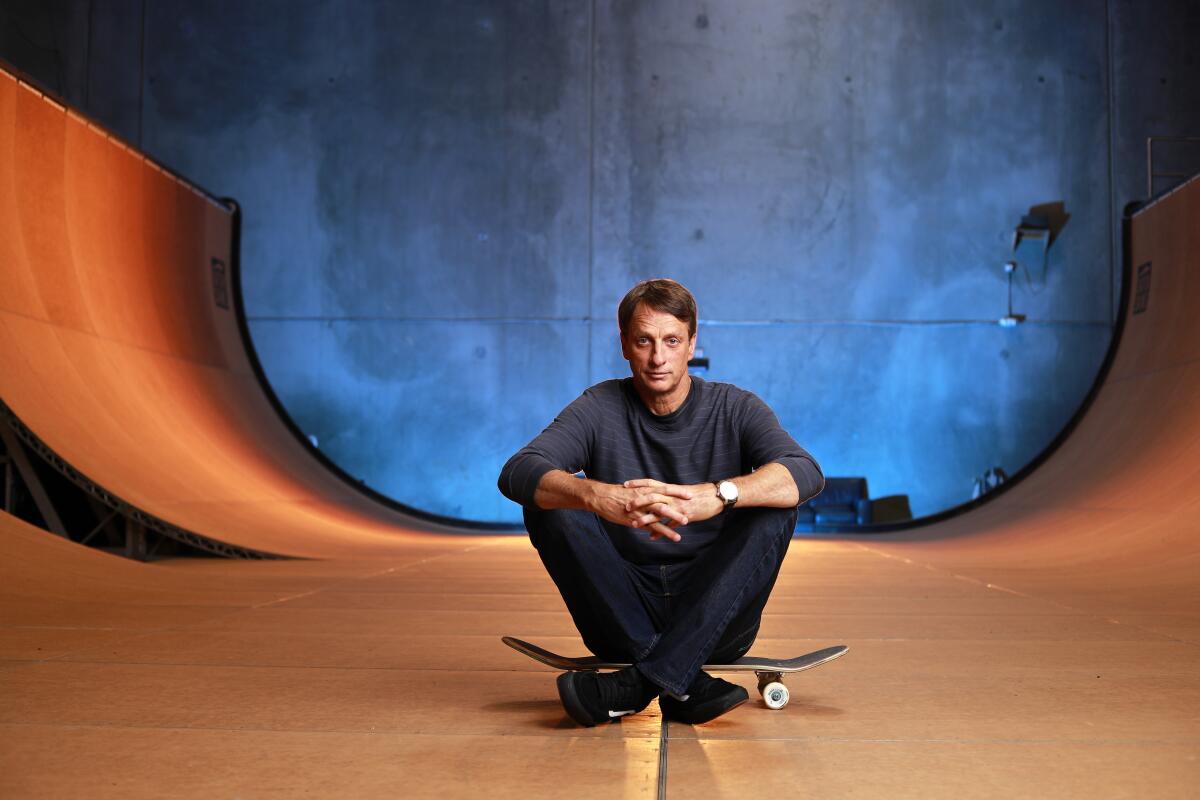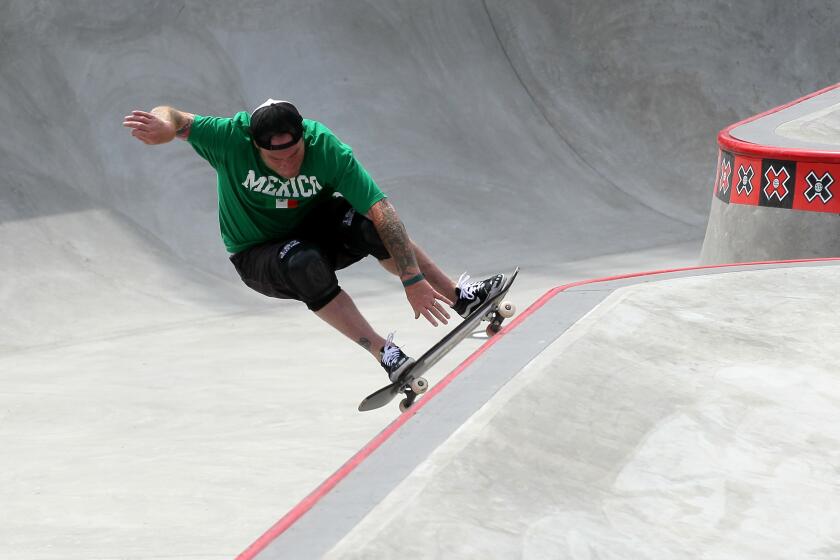Tony Hawk shares his memories of fellow skateboarding legend Jeff Grosso

- Share via
Tony Hawk’s first memory of Jeff Grosso is from when they were about 11 years old. It was at an amateur skateboarding event in Southern California. And Hawk was intimidated.
This was in the late 1970s, long before either Hawk, one of the most famous skateboarders of all-time, or Grosso, the skating icon who died last March, reached the heights of their professional careers.
Back then, they skated for nothing more than the love of their sport. And on this day, they were competing against each other — Hawk with his Oasis Skate Park team from San Diego and Grosso with his squad from the old Skate City Skate Park in Whittier.
“Whittier, to me, was always intimidating,” Hawks said in an interview with The Times. “The locals were very boisterous and funny and fiery. And if you came as an out-of-towner, you kind of got hazed. Jeff was a big part of that.”
Few people outside of the skateboarding world knew of Jeff Grosso before his death a year ago of a drug overdose. Yet few led as influential a life.
“But also,” Hawk continued, “I envied that crew. Because they were really creative.”
For the rest of their lives, Hawk’s and Grosso’s paths would cross, diverge, then cross again. Each of their careers helps tell important parts of skateboarding history. And after Grosso’s unexpected death a year ago from an accidental drug overdose, Hawk gave some of the most effusive praise for his friend’s importance to the sport.
“One of the last times we spoke, we talked about how ridiculous it is that we still get to do this for a living and that anyone even cares what we do or think in terms of skateboarding at our age,” Hawk wrote in an Instagram post after Grosso‘s death. “I believe Jeff is a big reason that anyone truly cares, and skateboarding was lucky to have him as an ambassador and gatekeeper to its history.”
Like Grosso, Hawk began skateboarding when the sport was suffering from declining popularity in the late 1970s and early ’80s. He remembered how, as a kid, he hid his skateboard at school to escape ridicule. His only reprieve came when he was at a skatepark, either with his own crew in San Diego or when meeting other skaters such as Grosso from around Southern California.
Neither expected the sport to bring them fame or status. But right at the start of their professional careers in the late ’80s — which, as was typical in skateboarding, began before they were even out of high school — skateboarding’s popularity boomed.
“We found ourselves in the strange position of being well known, and making money at a very young age,” Hawk said. “It was strange, but we navigated it. We had fun. It was crazy. We were traveling the world and still in high school.”
Hawk recalled one weeklong trip to Japan with Grosso, long known in the skateboarding community for his carefree disposition and off-the-cuff conversations.

“To be in such a foreign place with someone of his nature, of his personality, made it so much more fun,” Hawk said. “When I think of some of the most fun trips, that one was one of the most fun just because Jeff was there.”
By the time they reached their early 20s, however, skateboarding had shifted again. Their “vertical” skating style, making use of half-pipes and empty swimming pools, was overtaken in popularity in the early ’90s by street skating, a new discipline defined by tricks off urban obstacles such as staircases and handrails. Hawk, Grosso and most other skaters of their generation saw their careers come to a screeching halt.
“We all went through a downturn in the late ’80s, early ’90s,” Hawk said. “Skating was starting to lose popularity, but more so our style of skating … was dying even quicker. So we all kind of found ourselves with no jobs very quickly.”
For much of the ’90s, Hawk and Grosso fell out of touch. Grosso battled drug addiction and depression. Hawk struggled to keep his competitive career alive.
Jeff Grosso died last year of an accidental drug overdose. Here’s a primer on what made him a skateboarding legend.
But then their fortunes changed again. First, skating experienced another popularity spike, thanks in part to Hawk’s famous 900-degree spin at the 1999 X-Games. Then in 2005 Grosso got his life back together, announcing he’d achieved sobriety and reemerging as an influential figure in the sport — both by openly discussing his personal struggles and by bringing renewed attention to skateboarding’s culture through his popular “Loveletters to Skateboarding” YouTube show.
“He was definitely an inspiration for a new generation, in terms of how to respect your culture,” Hawk said. “The fact that he got clean, he was in recovery, people saw that as hope, especially people struggling with the same issues. But I liked that he wasn’t preaching only that. He weaved that into his narrative, but it wasn’t all he represented.”’
One of Hawk’s favorite memories of Grosso is a more recent one, when Grosso skated at Vans’ iconic Combi Bowl at a 2014 event. Hundreds of fans gathered around the concrete pit to watch Grosso grind on the top rail, go airborne off the end of ramps and pull off some of the memorable tricks that made him a star in the first place.
“He got the absolute best applause, best reaction,” Hawk said. “It was like the whole skateboard community came together to celebrate him. If they could have hoisted him up above them, they would have.”
More to Read
Go beyond the scoreboard
Get the latest on L.A.'s teams in the daily Sports Report newsletter.
You may occasionally receive promotional content from the Los Angeles Times.













